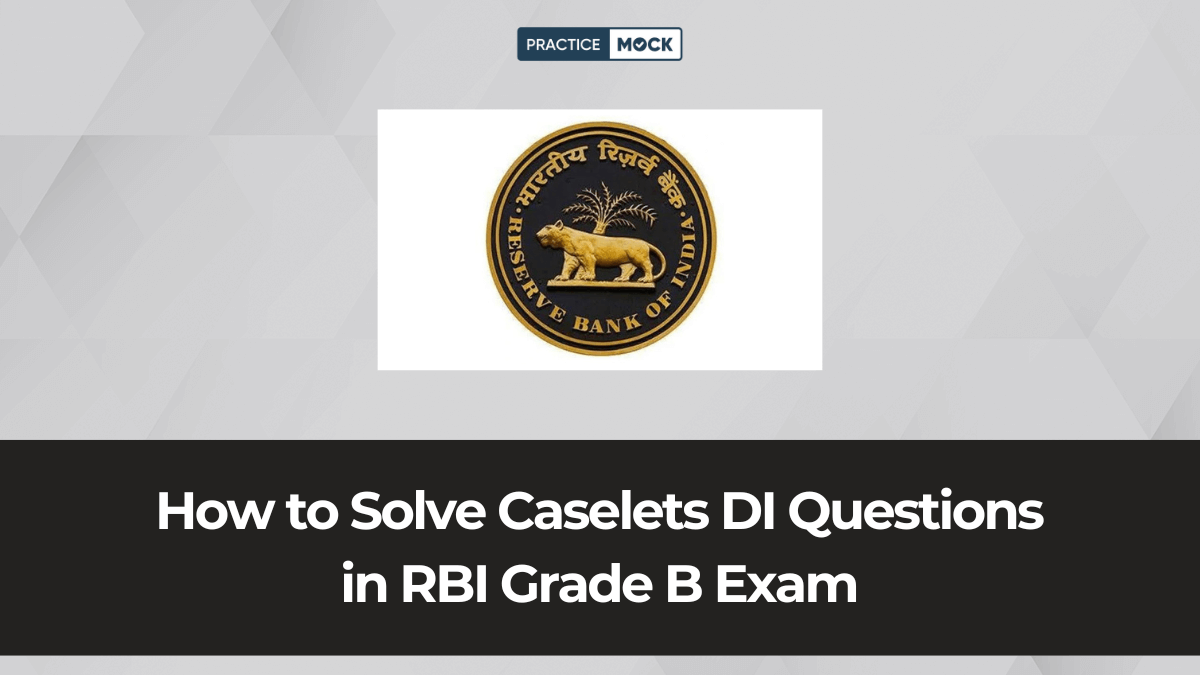Caselets Data Interpretation (DI) questions feature in the RBI Grade B Phase 1 exam. It is part of the Quantitative Aptitude section. These questions are constructed to test candidates’ ability to analyze and interpret data presented in a caselet format. This topic can greatly improve your total score. Mastering these questions, therefore, is of utmost importance. The ability to quickly solve Caselets DI will not only improve your performance in the DI part but also improve your time management skills. In this blog, we will provide you with important practice questions with solutions, packed with practical tips needed to master Caselets DI questions.
Important Caselets DI Questions and Solutions
Caselets DI involves understanding data presented in paragraphs, tables, or charts. It is important to find key details quickly and make calculations in an organized manner to solve these questions competently in the exam. So, the candidates should be ready to face the questions based on diverse topics like:
- Profit and loss
- Speed and distance
- Percentages
- Averages, and more.
Below, we have provided you with a few important questions to practice. These questions will help you gain knowledge of the format and the techniques needed to solve Caselets DI questions effectively.
Important Caselets DI Questions
Directions: Answer the questions based on the information given below.
In January, a sports company, Fox Pvt. Ltd conducted a survey in Delhi to find out about the popularity of three types of sports i.e., Cricket, Football and Rugby among its customers. Total number of people (men + women) who participated in the survey was ‘P’. A total number of people who like Cricket, Football, and Rugby was 150, 200, and 180, respectively. The number of people who like only cricket was equal to na umber of people who like exactly two types of sports. The number of people who like all 3 sports were (1/5)th of number of people who like Cricket, while a number of people who didn’t like any of the given three sports were (1/3)rd of number of people who like all three sports. The number of people who like only Rugby were 25% less than number of people who like only Cricket, which was 20% less than number of people who like only Football.
Question 1: What is the value of ‘P’?
A) 360
B) 382
C) 392
D) 400
E) 530
Question 2: How many people like both Football and Rugby?
A) 90
B) 88
C) 76
D) 86
E) Cannot be determined
Question 3: What is the difference between number of people who like both Cricket and Football and number of people who like both Rugby and Football but not Cricket?
A) 20
B) 22
C) 34
D) 30
E) 14
Question 4: What is the number of people who like neither cricket nor football?
A) 66
B) 84
C) 64
D) 80
E) 76
Question 5: If 50% of the number of people who like only cricket are men and two-third of the number of people who like only Rugby are also men, then what is the sum of number of women who like only cricket and only rugby.
A) 66
B) 44
C) 22
D) 50
E) None of these
ANSWER KEYS and SOLUTIONS:
| 1) – C) | 2) – D) | 3) – B) | 4) – E) | 5) – A) |
Solution 1: C)
Let number of people who like only cricket be ‘2x’
So, number of people who like exactly two types of sports = 2x
Number of people who like only Rugby = 0.75 × 2x = 1.5x
Number of people who like only Football = 2x/0.80 = 2.5x
Number of people who like all 3 sports = 150/5 = 30
Number of people who didn’t like any of the given three sports = 30/3 = 10
Let us represent the Venn diagram as follows:

So, (OC OF OR) 2(D E F) 3(G) = 530
Or, 6x 2 × 2x 3 × 30 = 530
Or, 10x = 440
Or, x = 44
Number of people who like only cricket = 2 × 44 = 88
Number of people who like only rugby = 1.5 × 44 = 66
Number of people who like only football = 2.5 × 44 = 110
ATQ;
D E = 150 – 88 – 30 = 32………………………(1)
And, E F = 200 – 110 – 30 = 60………………..(2)
And, D F = 180 – 30 – 66 = 84…………………(3)
Solving equation (1), (2) and (3), we get
D = 28, E = 4 and F = 56
So, number of people who like both cricket and rugby but not football = D = 28
Number of people who like both cricket and football not rugby = E = 4
Number of people who like both rugby and football but not cricket = F = 56

P = 88 + 4 + 110 + 28 + 30 + 56 + 66 + 10 = 392
Hence, option c.
Solution 2: D)
Desired number of people = 56 + 30 = 86
Hence, option d.
Solution 3: B)
Number of people who like both Cricket and Football = 30 + 4 = 34
Number of People who like both Rugby and Football but not Cricket = 56
Required difference = 56 – 34 = 22
Hence, option b.
Solution 4: E)
Number of people who liked neither Cricket nor Football = Number of people who like only rugby + number of people who doesn’t like any of the three given sports = 66 + 10 = 76
Hence, option e.
Solution 5: A)
Number of women who like only Cricket = 88/2 = 44
Number of Women who like only Rugby = 66/3 = 22
Required sum = 44 + 22 = 66
Hence, option a.
Tips to Master Caselets DI for RBI Grade B Exam
Now that you have seen some important practice questions, here are a few tips that you can practically implement while solving Caselets DI questions to masterthem:
- Read the Caselet Carefully: Always begin by reading the caselet carefully. Detect necessary information like totals, averages, ratios, and percentages that are relevant to the question.
- Break the Problem into Smaller Parts: Break the caselet into smaller sections or points. This will help you understand the problem better and allow you to focus on one part at a time.
- Use Shortcuts for Calculations: Practice mathematical shortcuts. These shortcuts will help you solve problems quickly. Plus, techniques like quick multiplication, approximation, and division can save a lot of time.
- Draw Tables or Diagrams: Draw tables or diagrams to organize the information, in case the data is complicated. Visualizing the data. The visualization process will make it easier to interpret and solve.
- Stay Calm and Manage Your Time: Caselets DI questions can be tough and time-consuming. So, don’t rush. Stay calm and manage your time effectively to solve these questions within the time limit.
Takeaway
Mastering Caselets DI questions for the RBI Grade B exam requires practice and strategy. You can master this topic by mastering the art of understanding the format of questions, breaking the problem into smaller parts, and using shortcuts. Regular practice will further improve your performance. Make sure to practice regularly and time yourself to improve your solving speed. Don’t forget to take our FREE RBI Grade B Phase 1 Mock Test to measure your preparedness and improve your self-confidence!

Join our unique Telegram group immediately to skyrocket your preparation for Regulatory exams via expert guidance, top tips, perfect feedback, and much more!
[ Click Here to join the PracticeMock Telegram Group! ]
[ Click Here to join the PracticeMock Telegram Discussion Group Link! ]
Related Posts:
Caselets DI presents data in paragraph form and tests data interpretation skills in the Quant section.
Yes, they are commonly asked in Phase 1 and can boost your Quant score significantly.
Topics include averages, percentages, speed-distance, and profit-loss
Use shortcuts, visualize data with tables, and break down information step-by-step.
Solve past questions, use mock tests, and focus on time management.
- Sign Up on Practicemock for Updated Current Affairs, Free Topic Tests and Free Mini Mocks
- Sign Up Here to Download Free Study Material
Free Mock Tests for the Upcoming Exams
- IBPS PO Free Mock Test
- RBI Grade B Free Mock Test
- IBPS SO Free Mock Test
- NABARD Grade A Free Mock Test
- SSC CGL Free Mock Test
- IBPS Clerk Free Mock Test
- IBPS RRB PO Free Mock Test
- IBPS RRB Clerk Free Mock Test
- RRB NTPC Free Mock Test
- SSC MTS Free Mock Test
- SSC Strenographer Free Mock Test
- GATE Mechanical Free Mock Test
- GATE Civil Free Mock Test
- RRB ALP Free Mock Test
- SSC CPO Free Mock Test
- AFCAT Free Mock Test
- SEBI Grade A Free Mock Test
- IFSCA Grade A Free Mock Test
- RRB JE Free Mock Test
- Free Banking Live Test
- Free SSC Live Test



